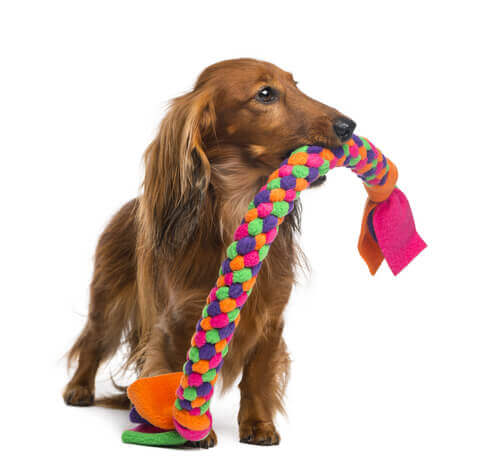Make Resistant Chew Toys for Dogs in 6 Steps

The chew toys for pets that we buy in the store are usually expensive and barely last an hour. Because of that, many owners choose to make them themselves with items they have at home. In this article, we’ll tell you how to make very resistant chew toys for dogs.
Chew toys for dogs
In the store, we can find all kinds of toys and objects for our pets, but chew toys, or teethers, are the best option. Why? Because they can help you teach your dog different tricks and commands, and they’re also great for normal training.
It doesn’t matter what breed your dog is, whether he’s a boxer or a poodle. A teether will help work on his bite, his grip on objects and releasing objects when you tell him to do so.
Of course, it’s also an excellent tool to teach him to fetch. Running and fetching exercises are a great way to ensure our pet is well-balanced and obedient.
Chew toys are great for dogs because they’ll satisfy your pet’s hunting instinct. He’ll be able to channel this instinct while playing. They also help to keep your dog from destroying the furniture, our shoes or our clothes. This is a very common habit for dogs that are home alone for several hours a day.
Chew toys will also strengthen your dog’s jaw, back and neck muscles. Additionally, they’ll keep his teeth healthy by eliminating food debris and helping with saliva production that removes tartar from his mouth.

How to make resistant chew toys for dogs
Forget about the myth that chews make dogs more competitive and aggressive. If your dog becomes too excited when playing with one, you should give him a sign to calm down or stop playing for a while.
Now that you know all the benefits of these toys, it’s time to make one for your pet. All you need are some t-shirts or some fabric that you don’t use anymore, and some scissors. These are the steps to follow:
1. Cut the fabric into equal sized strips. If you have a large dog, you’ll need 18 strips; half that many if he’s small. The most important thing is that you have multiples of three (you’ll find out why).
2. Unfold each strip to make longer strips.
3. Take three strips and make a braid. Repeat this with the other strips. Don’t forget to tie knots at both ends.
4. Join the three braids into one large braid. If your dog is small, that’s all the work you’ll need to do. However, if he’s bigger, you’ll need to do this two more times. In the end, you’ll have three large braids.
5. Lastly, take the three braids and make one that’s even bigger and more resistant. Remember to knot the ends and leave some loose strips on the ends too.
6. Show your pet his new gift and let him start enjoying it as soon as possible. You can go to the park, to the yard or even stay at home and play if you have enough space.

Other ideas for chew toys
In addition to making resistant chew toys with old fabric, there are other easy, homemade options that your pet can play and learn with:
1. A plastic bottle toy
Take a plastic bottle, remove the lid, labels, and rings. Squeeze the bottle before giving it to your dog. Watch to make sure he doesn’t hurt himself when he bites it. Try covering it with a sock to make it safer.
2. Toy with a treat
Instead of squeezing the bottle completely, just press it in a little. Then, put a treat inside like biscuits or anything edible that makes a noise. Your pet will love it! Don’t forget to put the lid on the bottle!
3. Toy with a towel
If you have a towel you don’t use anymore, roll it up like a cylinder and tie two strips of cloth at the ends.
Whatever kind of toy he plays with, we recommend you keep an eye on your pet. This will help you avoid any accidents and will keep him out of danger.
The chew toys for pets that we buy in the store are usually expensive and barely last an hour. Because of that, many owners choose to make them themselves with items they have at home. In this article, we’ll tell you how to make very resistant chew toys for dogs.
Chew toys for dogs
In the store, we can find all kinds of toys and objects for our pets, but chew toys, or teethers, are the best option. Why? Because they can help you teach your dog different tricks and commands, and they’re also great for normal training.
It doesn’t matter what breed your dog is, whether he’s a boxer or a poodle. A teether will help work on his bite, his grip on objects and releasing objects when you tell him to do so.
Of course, it’s also an excellent tool to teach him to fetch. Running and fetching exercises are a great way to ensure our pet is well-balanced and obedient.
Chew toys are great for dogs because they’ll satisfy your pet’s hunting instinct. He’ll be able to channel this instinct while playing. They also help to keep your dog from destroying the furniture, our shoes or our clothes. This is a very common habit for dogs that are home alone for several hours a day.
Chew toys will also strengthen your dog’s jaw, back and neck muscles. Additionally, they’ll keep his teeth healthy by eliminating food debris and helping with saliva production that removes tartar from his mouth.

How to make resistant chew toys for dogs
Forget about the myth that chews make dogs more competitive and aggressive. If your dog becomes too excited when playing with one, you should give him a sign to calm down or stop playing for a while.
Now that you know all the benefits of these toys, it’s time to make one for your pet. All you need are some t-shirts or some fabric that you don’t use anymore, and some scissors. These are the steps to follow:
1. Cut the fabric into equal sized strips. If you have a large dog, you’ll need 18 strips; half that many if he’s small. The most important thing is that you have multiples of three (you’ll find out why).
2. Unfold each strip to make longer strips.
3. Take three strips and make a braid. Repeat this with the other strips. Don’t forget to tie knots at both ends.
4. Join the three braids into one large braid. If your dog is small, that’s all the work you’ll need to do. However, if he’s bigger, you’ll need to do this two more times. In the end, you’ll have three large braids.
5. Lastly, take the three braids and make one that’s even bigger and more resistant. Remember to knot the ends and leave some loose strips on the ends too.
6. Show your pet his new gift and let him start enjoying it as soon as possible. You can go to the park, to the yard or even stay at home and play if you have enough space.

Other ideas for chew toys
In addition to making resistant chew toys with old fabric, there are other easy, homemade options that your pet can play and learn with:
1. A plastic bottle toy
Take a plastic bottle, remove the lid, labels, and rings. Squeeze the bottle before giving it to your dog. Watch to make sure he doesn’t hurt himself when he bites it. Try covering it with a sock to make it safer.
2. Toy with a treat
Instead of squeezing the bottle completely, just press it in a little. Then, put a treat inside like biscuits or anything edible that makes a noise. Your pet will love it! Don’t forget to put the lid on the bottle!
3. Toy with a towel
If you have a towel you don’t use anymore, roll it up like a cylinder and tie two strips of cloth at the ends.
Whatever kind of toy he plays with, we recommend you keep an eye on your pet. This will help you avoid any accidents and will keep him out of danger.
All cited sources were thoroughly reviewed by our team to ensure their quality, reliability, currency, and validity. The bibliography of this article was considered reliable and of academic or scientific accuracy.
FAGNANI, J. P., Barrera, G., & Bentosela, M. (2016). Control inhibitorio en perros domésticos:¿qué sabemos hasta ahora? Avances En Psicología Latinoamericana. https://doi.org/10.12804/apl34.3.2016.11
This text is provided for informational purposes only and does not replace consultation with a professional. If in doubt, consult your specialist.








